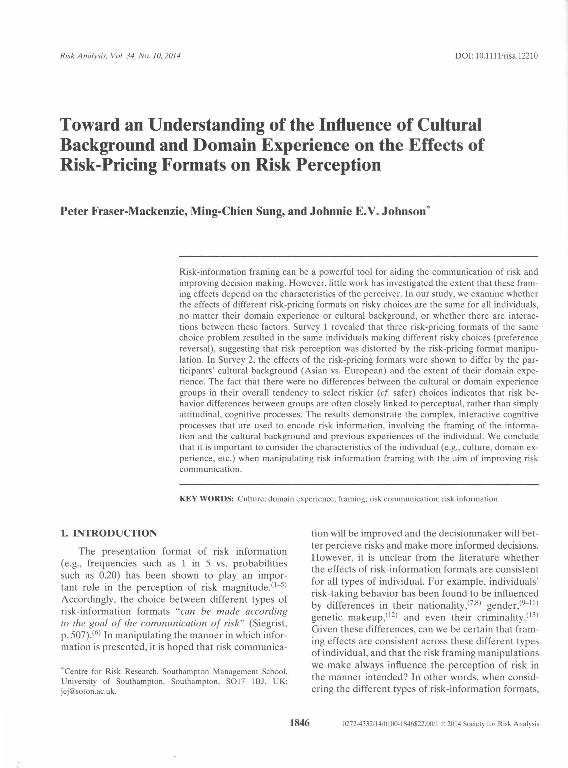Toward an understanding of the influence of cultural background and domain experience on the effects of risk-pricing formats on risk perception

Contenido multimedia no disponible por derechos de autor o por acceso restringido. Contacte con la institución para más información.
| Tag | 1 | 2 | Valor |
|---|---|---|---|
| LDR | 00000cab a2200000 4500 | ||
| 001 | MAP20150001542 | ||
| 003 | MAP | ||
| 005 | 20150128165904.0 | ||
| 008 | 150112e20141006usa|||p |0|||b|eng d | ||
| 040 | $aMAP$bspa$dMAP | ||
| 084 | $a7 | ||
| 100 | 1 | $0MAPA20150002303$aFraser-Mackenzie, Peter | |
| 245 | 1 | 0 | $aToward an understanding of the influence of cultural background and domain experience on the effects of risk-pricing formats on risk perception$cPeter Fraser-Mackenzie, Ming-Chien Sung, Johnnie E.V. Johnson |
| 520 | $aRisk-information framing can be a powerful tool for aiding the communication of risk and improving decision making. However, little work has investigated the extent that these framing effects depend on the characteristics of the perceiver. In our study, we examine whether the effects of different risk-pricing formats on risky choices are the same for all individuals, no matter their domain experience or cultural background, or whether there are interactions between these factors. Survey 1 revealed that three risk-pricing formats of the same choice problem resulted in the same individuals making different risky choices (preference reversal), suggesting that risk perception was distorted by the risk-pricing format manipulation. In Survey 2, the effects of the risk-pricing formats were shown to differ by the participants' cultural background (Asian vs. European) and the extent of their domain experience. The fact that there were no differences between the cultural or domain experience groups in their overall tendency to select riskier (cf. safer) choices indicates that risk behavior differences between groups are often closely linked to perceptual, rather than simply attitudinal, cognitive processes. The results demonstrate the complex, interactive cognitive processes that are used to encode risk information, involving the framing of the information and the cultural background and previous experiences of the individual. We conclude that it is important to consider the characteristics of the individual (e.g., culture, domain experience, etc.) when manipulating risk-information framing with the aim of improving risk communication. | ||
| 650 | 4 | $0MAPA20080591182$aGerencia de riesgos | |
| 650 | 4 | $0MAPA20080579258$aCálculo actuarial | |
| 650 | 4 | $0MAPA20080602871$aPercepción del riesgo | |
| 650 | 4 | $0MAPA20080589165$aAspectos culturales | |
| 650 | 4 | $0MAPA20080609788$aComunicación del riesgo | |
| 650 | 4 | $0MAPA20080606688$aInferencia estadística | |
| 650 | 4 | $0MAPA20080611613$aModelos probabílisticos | |
| 700 | 1 | $0MAPA20150004918$aSung, Ming-Chien | |
| 700 | 1 | $0MAPA20150004925$aJohnson, Johnnie E.V. | |
| 773 | 0 | $wMAP20077000345$tRisk analysis : an international journal$dMcLean, Virginia : Society for Risk Analysis, 1987-2015$x0272-4332$g06/10/2014 Volumen 34 Número 10 - octubre 2014 , p. 1846-1869 |

